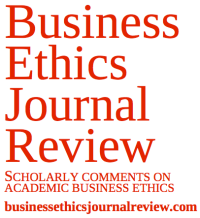v4 n5 Thauer Responds to van der Ven
Posted: April 13, 2016 Filed under: Uncategorized 1 Comment “The Choice for CSR: Strategic Rationale versus Values?” by Christian R. Thauer
“The Choice for CSR: Strategic Rationale versus Values?” by Christian R. Thauer
A RESPONSE TO Hamish van der Ven (2013), “Bringing Values Back into CSR”, Bus Ethics J Rev 1(16): 99–105.
Abstract: In a recent Commentary, Hamish van der Ven criticizes my strategic rationale-based approach to why firms decide to adopt and implement CSR standards. He argues that my approach is analytically flawed; rather than strategic rationale, values motivate firms in favor of CSR. In this response, I explain why I disagree with his criticism and approach. I maintain that strategic rationale, not values, drive firms’ decision-making for CSR.
To download the full PDF, click here: Thauer responds to van der Ven



I thank Prof. Thauer for responding to my original review and hope that our debate inspires a broader exchange on the drivers of corporate social responsibility, either in this forum or elsewhere.
In response to criticism one, a quick clarification. My original critique of Prof. Thauer’s work questioned its ability to explain instances of CSR amongst companies with unskilled labor forces. In lay terms, if CSR is driven by a need to hold onto skilled workers, why would a company invest in CSR for unskilled labourers? How would asset specificity theory account for investments in unskilled labourers, for example, when agricultural businesses pursue Fairtrade certification? My critique was not, as implied in the response, that your theory doesn’t explain why companies with unskilled labor forces fail to invest in CSR. Rather, it’s the cases that would falsify your theory that interest me.
To this point, I remain unconvinced by the response that Fairtrade is a superficial commitment that allows companies to mask “what they actually do.” Further empirics would be needed to support this statement. The instances where companies DO invest in unskilled labor remain outside the boundary of asset specificity theory and this is where values, particularly executive values, can add analytic leverage.
In response to criticism two, I’ll buy Prof. Thauer’s argument that firms use CSR to reduce their exposure to volatility in the investment environment (e.g., the long-term cost of energy), but I remain puzzled by the logic underlying the second causal mechanism of internal driver 2. The argument is that a sub-unit may use information asymmetries to gain the upper-hand over management. Quality and environmental standards are used by management to reduce these information asymmetries. But a gap remains in the logic of this argument. Exactly what information asymmetries is the sub-unit using to improve its bargaining position here? And how would those asymmetries be mitigated through an EMS like ISO 14001? I struggle to see what this would look like in practice and how ISO 14001 would allow management to preserve the upper-hand.
In response to criticism three, as I’ve stipulated elsewhere (van der Ven 2014), it’s not just the values of managers that matter, it’s the seniority of those managers and their ability to drive change down through their organizations. Prof. Thauer is correct that mid-level managers confront a plethora of decisions each day and do not have the opportunity to put their values into action. However, firms with a CSR champion in the “C-Suite” are far more likely to implement CSR, even when confronted with similar strategic rationales (I expand on this argument: in van der Ven 2014).
To be clear, my argument is not that strategic imperatives don’t matter. Prof. Thauer’s book provides compelling evidence to suggest that they do. Rather, I counter that rational decision-making only tells part of the story. A more comprehensive account of what drives CSR would equally account for the unpredictable ways in which the values of executives and managers often drive CSR. Admittedly, such an approach would entail trade-offs in parsimony, generalizability, and theoretical elegance, but it may yield vital insights into how external stakeholders can steer companies towards improved CSR practices.
Reference:
van der Ven, Hamish. 2014. “Socializing the C-Suite: Why Some Big-Box Retailers are ‘Greener’ than Others.” Business and Politics 16(1): 31-63.